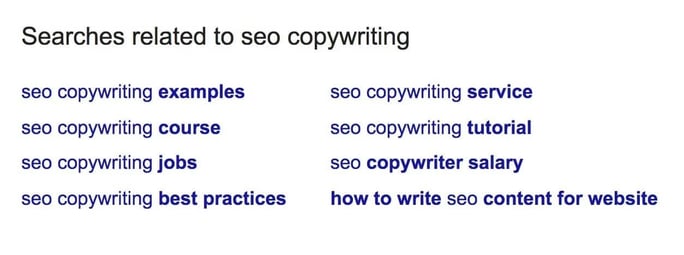Great SEO copywriting is the key to thriving online.
But one of the biggest challenges for SEO copywriters is creating content that is favoured by online searchers and search engines.
The job of an SEO copywriter has demanded a variety of disciplines in previous years. Now, it's not enough to write for algorithms. You must write for people first.
This means your writing must speak to your audience's needs and desires, while, at the same time, targeting specific keywords and following SEO best practices.
The problem is that too many of us have approached SEO copywriting with a blinkered focus on keywords, forgoing the quality of body content in the process.
In 2018, user behaviour is the foundation on which SEO algorithms are changing. And with the volume of online content growing infinitely, you need to work at creating the most appealing and compelling content that is aligned with the needs of your searchers.
User intent matters more than matching exact keywords
Unfortunately, there's no magic formula to guarantee you a number one spot on SERPs.
But that’s because good online copywriting isn’t formulaic. It shouldn't follow a template or diagram. It should be valuable, easy to digest and satisfy the user’s intent.
But what is the user intent? And how do you find out what it is?
By defining your buyer personas you're equipped with the information to help shape your keyword strategy so that the topics are aligned with the buyer's biggest challenges, values and obstacles.
A B2B searcher tends to have a problem or a pain that is preventing them from effectively delivering their service to customers.
Their search intention tends to be informational, and they'll use the internet a channel for research to identify a problem.
Once they have identified the problem, they will begin to consider the best solution. From there, they will decide which avenue they'll take to overcome this problem, whether that is through implementing some of their newfound knowledge, or employing the services of another business. This is what is referred to in inbound marketing as the buyer’s journey.
Keywords are still very much part of that equation, but they do not hold as much weight as they used to.
The key to SEO authority is to attract links and social sharing through compelling content. Before you publish, ask yourself, will this create value for my target readers? If it does, then it’s likely to create value for their peers too, and that will encourage shares and links.
Getting the balance right between writing for users and writing for search engines can be tricky, but here are the three main components of SEO copywriting to consider:
1. Buyer and keyword research
Defining your buyer persona and understanding their intent, their language, needs and struggles can help you shape a more accurate SEO strategy. This insight will enable you to define a keyword strategy that is informed by your searchers' behaviour.
What types of questions is your prospective buyer likely to have that will lead them to a business like yours? What is your searcher actually trying to accomplish? Once you can answer this question, you can build content with a purpose. And purposeful, meaningful content that engages your reader is the most favoured by Google.
Remember to make use of the Google ‘Related Search’ box. This provides valuable research into the types of queries related to your keyword. For example, let’s say your keyword is ‘SEO copywriting’.

This tool is a hidden treasure. It essentially generates eight, free content ideas for you. You can bank these into a content calendar or start thinking about how to satisfy those queries within your existing or related content.
You could then drop these keywords into your keyword planner tool, where you’ll discover if they’re worth ranking for.
Below is an example taken from Hubspot’s keyword planner tool. If a related term warrants its own post, then there's an opportunity to create another page dedicated to that keyword, where you can start to build a topic cluster.

Do be wary of trying to cover too many topics in one post which could cause your content to become vague and lose the attention of the user. Remember, in 2018, it’s all about the user. Write for your audience first, search engine second.
2. Content creation
From your keywords and buyer questions, you can devise your body content, whether that be in the form of a blog, an ebook or a video; the format will be informed by your audience's preferences. But, it should be full of relevant and helpful information that satisfies not only the keyword strategy but your user’s intent.
Good content is the key to climbing up SERPs. You can have your keyword strategy down to a tee, but if your content is unfulfilling, irrelevant or poorly written, the chances are your bounces rates will reflect this. And a low bounce rate will harm your reputation in the eyes of Google. They tell Google that users haven't found your content helpful or engaging, hence leaving the page after a few short seconds. So why would Google want to present other users with your content?
On the other hand, if your readers have stayed on the page long enough to read the article, followed links deeper into your site and found your content valuable enough to share on their social channels, Google immediately considers you a high-quality source. So keep it helpful, relevant and informative but most importantly, deliver information that satisfies your searchers’ queries.
3. On-page and off-page optimisation
Write your content first, then come back to optimise. By approaching things this way round, you can concentrate on fulfilling the purpose of the content without getting too hung up on keywords.
Once your first draft is ready, you can perform all of the necessary on-page and off-page SEO techniques. First, optimise your body content, meta descriptions, images and H1s etc. Then, focus on your off-page elements such as link-building, social promotion, acquiring backlinks and influencer outreach.
It's essential you also consider topic clusters and pillar content as a part of your optimisation endeavours. This ensures you rank for topics as well as keywords, and during the process, you'll identify opportunities for other content topics to support your 'pillar' content. We have covered this subject widely in the past, so do take the time to read some more of our content around topic clusters and pillar pages.
Copyblogger summarises a good SEO copywriter perfectly, as someone who has “flair for writing content that’s inviting to share and to link to. She needs to have top-notch skills to optimise the page, so search engines know what it’s about and who might want to read it. And she needs to know how to write copy that converts readers to buyers.”
To master good SEO copywriting, you essentially have to be good at creating content that is in tune with the needs and desires of your prospective buyers, with a knack for hitting all of the SEO elements too. And, everything needs to be organic; black hat techniques will be reprimanded just as they always were and have consequences for the future of your reputation.
I hope this post has offered some insight into the changing landscape of SEO, as well as equipping you with the knowledge to re-shape and update your strategy where needed. By providing your readers with valuable, authoritative content, you create content that is remarkable, compounding and worthy of shares. This, paired with on-page and off-page optimisation practices, is the key to thriving online.


